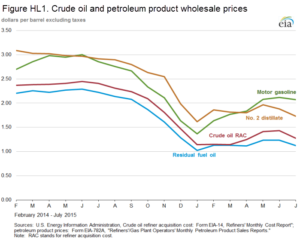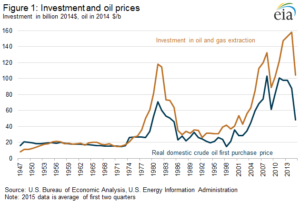 Dampened oil prices could mean less investment in exploration and production, the U.S. Energy Information Administration reports.
Dampened oil prices could mean less investment in exploration and production, the U.S. Energy Information Administration reports.
Data released Oct. 1 by the EIA showed average crude oil prices down in all sales categories in July.
The average domestic crude oil first purchase price fell 14.6 percent, or $8.18, to $47.70 per barrel.
“Low oil prices, if sustained, could mark the beginning of a long-term drop in upstream investment,” the EIA reports. “Oil prices reflect supply and demand balances, with increasing prices often suggesting a need for greater supply. Greater  supply, in turn, typically requires increased investment in exploration and production activities. Lower prices reduce investment activity.”
supply, in turn, typically requires increased investment in exploration and production activities. Lower prices reduce investment activity.”
A boom in investment, cresting at $100 billion (in 2014 dollars), occurred with the rise in oil prices in 1981 and 1982. But in the early 2000s, investment averaged $30 billion to $40 billion per year, reflecting the fall in crude oil prices. Projections of prices of $70 per barrel in 2020 “could result in substantially lower annual oil and gas investment” in the next five years, EIA says.
Read more about the issue here: Click Here





